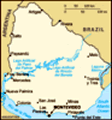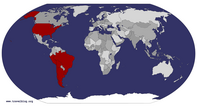Advertisement
Published: January 17th 2011
Old, well-preserved/restored colonial towns are some of my favorite places, and Colonia de Sacramento is a gem. The
Barrio Histórico (historic neighborhood) is a UNESCO World Heritage site of small, charming, 17c buildings (now often museums or restaurants), rough, cobble-stone streets and a lighthouse tucked inside a ruined convent--all snuggled in a peninsula that juts into the wide, Rio de la Plata. Like the rest of the town, its streets are shaded by bowers of ancient, leafy sycamore trees, cooling me from the ever-increasing summer sun.
Colonia enjoys a Mediterranean climate similar to Santa Barbara's, and my heart leaped to see familiar hanging wisteria, vibrant bougainvillea, fragrant oleander, purple jacaranda and lots more. I was in paradise and stayed days longer than the few hours needed to explore the tiny old town. Like many places I was to visit in Uruguay, I felt I could live there for some time.
Most visitors enter Colonia from Buenos Aires, which is a short, one-hour ferry ride across the Rio de la Plata which separates the countries. However, I was one of the very few coming down the Uruguay River that separates the two countries in the northwest.
It took me
three buses and seven hours to get the roughly 120 kilometers from Gualeguychu, Argentina, to Colonia. I was lucky it only took that long because until only a couple of months before, the border between the two countries had been closed due to Argentine protests about Uruguay's allowing foreign companies to build polluting paper mills on the Uruguay River they share as a border.
On the buses into the country, it first felt as if we were crossing Kansas--endless, wide-open fields of newly-harvested wheat, rolled up into plump rolls (curious that wheat was being harvested in the summer, but maybe this was a winter crop). This was also the interior--gaucho land, though it seemed that farms had displaced some of the herds. Finally, small rolling hills popped up, dotted with vineyards, and I even saw a polo match. Soon after, I smelled a road-kill skunk for the first time in South America. It was great to have some familiar sights and smells.
From Colonia's bus station, I walked uphill to the closest, cheapest lodgings, Hostel El Espanol. It was charming and built around two courtyards in a rambling colonial style with friendly, helpful people. The first night, I

 the famous Street of Sighs
the famous Street of Sighs
with original paving and leading to the rivereven had a room to myself. After that, I shared it with travelers from all over southern South America.
The next morning arrived full of sun sending shafts of light through the sycamores. I wandered and photographed the old town with its plazas, church, famous Street of Sighs, colorful, old buildings and their romantic street lights. At sunset, I had great views from the top of the lighthouse that had been built against the sturdy, meter-thick walls of a ruined 17c convent. I was so lucky to have sun that day because it was followed by daily showers and gray skies for almost a week.
Yet these rainy days were great fun, too, for I just cuddled in my hostel bed reading and listening to the majestic claps of thunder and the rain pattering on the stone street outside. (How great that hostels no longer kick you out at 9 or 10 am, as in the old days). All this rain lengthened my stay here. As a Californian, I often walk out in the noon-day sun, but I would never walk out in the rain.
Colonia's history was one of lemons to lemonade, like almost all well-preserved,

 Spanish red-tiled roof
Spanish red-tiled roof
on low, Portuguese stone homeancient towns. Once prosperous, it had fallen into decline, and the poverty-ridden population was unable to tear down the old and modernize. Lucky for us who love the illusion of traveling back in time (one of the reasons I got a Master's in history was to flesh out my daydreams of living in other eras/countries).
In the 17c, Spain was developing its colonies in now-Argentina while Portugal was doing the same in Brazil. Between them, present-day Uruguay was rather ignored. Then in 1680, the Portuguese founded Colonia to smuggle goods across the river into Buenos Aires without paying taxes to Spain. In response, the Spanish established the citadel of Montevideo in 1726. The race was on to control the eastern side of the Rio de la Plata and the eastern side of the Uruguay River. (Uruguay's full name is the
Republica Oriental del Uruguay which means "the republic to the east of the river Uruguay." For the next century, these two plus England fought over control of the land.
For years, Colonia did great business as a Portuguese contraband port. To protect the city, it was surrounded by thick walls. The original, stone city gate with a wooden
drawbridge and moat have been reconstructed near part of old walls. One day, a group of Brazilians in fabulous 18c costumes marched up to the walls, scaled them and hoisted a flag--very dramatic and great fun.
In the 17c, as the Portuguese built the streets in the fortress, they let them meander and follow the terrain as opposed to the grids later imposed in the new town by Spanish settlement. The streets were constructed of very rough-cut, stones, and are charming, but killers on the joints; thus, golf-carts and mini-cars zipped the less-agile around the streets. Similar streets are still found in Brazil's colonial cities, such as Paraty and Ouro Preto (see my blogs on these).
The Portuguese constructed one-story, stone roofed, stone buildings, often around a patio. Some of these were upgraded during periods of Spanish control when second stories and red-tile roofs were added. When there were funds, the walls were plastered and white-washed. Now it's fun picking out the different elements that differentiate the styles. The city has also affixed old-style street lamps to buildings giving the whole area a very romantic feel.
Several of the old buildings had been turned into small museums.
I'm a big fan of small museums and know to leave expectations at the doorway and appreciate the nuggets to be uncovered. Too often, I see visitors simply duck in, glance around and grumble out. Small museums have a lot to offer if one takes the time to feel the building, read the signs and captions and sense what the artifacts meant in the lives of the previous owners.
The tiniest museum, the Casa of Nacarello, was only three rooms. Filled with 18c period furniture and simple furnishings, it provided a great understanding of how a typical Portuguese family lived. Amazing to think of spending hours on that hard, little stool, cook in front of that smokey fireplace and live with how many people in that small apace?
Next door to the tiny house was the big Municipal Museum, housed in an admiral's grand, two-story house. In the US, you just don't find a tiny house next door to a huge one. This integration of classes in living areas spoken volumes without even entering the museums. Here, there was a great natural history collection from the prehistoric armadillo-like creature through modern butterflies and birds, as well as well

 great doorways
great doorways
rather like Santa Barbara's Meridian studiosas historical artifacts from natives, gauchos, soldiers, town-folk, and important historical figures. My fave was a 3-dimensional mock-up of Colonia in the 18c--I love maps and the more 3-D, the better.
From the Indigenous Museum, I learned that 7 distinct groups had populated Uruguay before contact. They had been dying out until in 1828, the first president of independent Uruguay, authorized their extermination. This was carried out at Salsipuedes (Leave If You Can) and Mataojos (Kill the Eyes). Thus, Uruguay has a population that is about 90% European heritage, with the mestizo population resulting from modern immigration.
One night when I was there, it was Museum Nights all over Uruguay. Museums were free and with music, treats and wine tasting (like our First Thursdays). However, in Colonia, it was canceled due to rain. Ditto the sound and light show I tried to catch twice at the 1808 Basilica--boo hoo.
I also tried to get to the presidential retreat center and supposedly-beautiful park lands with native flora and fauna at Aaron de Anchorena, 30 km from Colonia. I visited and called many tour centers, but since the summer tourist flood was not yet upon us, I was always
the only one requesting a visit; private tours are just not in my budget. However, if you're here in the summer, or if you have your own car, my Montevideo colleague, Fede, assures me, it's a great excursion.
I did attend a great Mozart and Vivialdi choral concert at the Bastion del Carmen, once a factory and wharf, now a theater and cultural center. Other nights, there was popular music as well as the
candombe drumming that is played for Carnival, which is rather lively here.
I spent a lovely week, wafting gently about town, reading and chatting with friends from the hostel, visiting a tiny museum or two a day, and walking along the riverside promenade. Finally, I was ready to leave. Montevideo was a logical next stop, but I decided to pass it and head to the 340 km of beaches in eastern Uruguay before the hordes descended for Christmas. Magical beaches, here I come!
Advertisement
Tot: 0.137s; Tpl: 0.014s; cc: 12; qc: 28; dbt: 0.0497s; 1; m:domysql w:travelblog (10.17.0.13); sld: 1;
; mem: 1.1mb



























